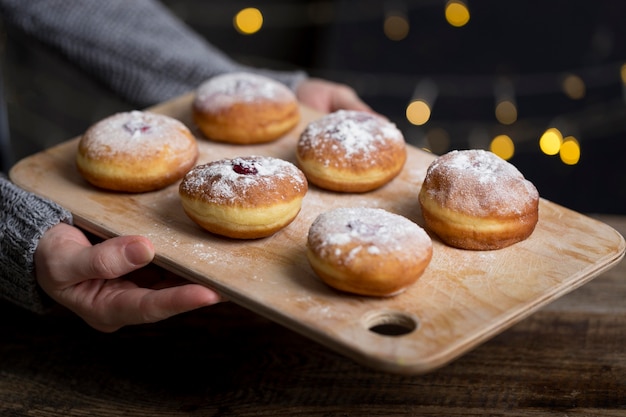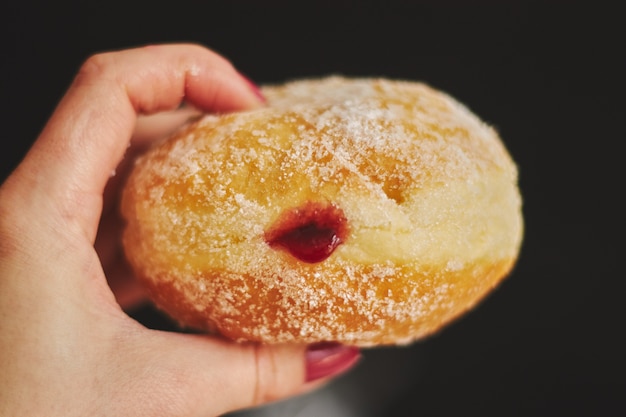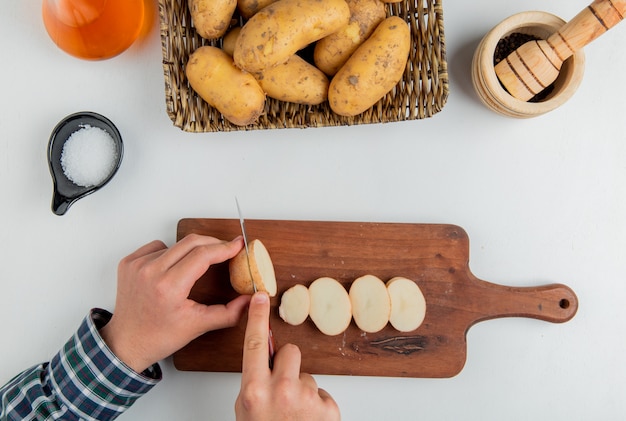Let's face it, there's nothing quite like the satisfaction of biting into a perfectly baked bagel. That chewy, doughy texture, the satisfying crunch of the crust, and the endless possibilities for toppings and fillings – it's pure bliss. And the best part? You can recreate this magic in your own kitchen!
I've been on a bagel baking quest for years, and let me tell you, it hasn't been easy. I've faced burnt bottoms, deflated doughs, and a whole lot of frustration. But, through trial and error (and a few burnt offerings), I finally cracked the code. Now, I'm sharing everything I've learned to help you bake those chewy, pillowy, and gloriously crusty bagels that will have your family and friends begging for more.
(Part 1) The Big Picture: The Bagel Journey

Think of baking a bagel as a journey. It's a journey with specific steps, each crucial to achieving that perfect, satisfying bite. We'll start with the right ingredients, move on to kneading and shaping, and then delve into the boiling and baking processes. Finally, it all culminates in that glorious moment when you pull a perfectly golden, crisp bagel out of the oven. Ready to embark?
1. The Crucial Ingredients: The Foundations of a Great Bagel
We'll start with the basics, the building blocks of our delicious journey. The secret to a good bagel, in my opinion, lies in the quality of the ingredients. It's all about choosing the right flour, yeast, and water.
Flour: The Backbone of Your Bagel
High-protein flour, also known as bread flour, is your go-to for bagels. It's the key to that satisfying chewiness. The higher protein content translates to more gluten, which is what gives the bagel its structure and that signature chew. Aim for a flour with at least 12% protein content for best results.
Yeast: The Magic Ingredient
Active dry yeast is the magic ingredient that makes those bagels rise. It's a living organism that feeds on sugar and releases carbon dioxide, creating those air pockets that give the bagel its light and airy texture. Always make sure your yeast is fresh; I always give it a good sniff before using it. It should smell slightly yeasty, not stale or musty. If it smells off, it's probably not going to work its magic.
Water: More than Just a Liquid
The water is the element that brings everything together. It activates the yeast and helps develop the gluten in the flour. I like to use cold water for bagels, as it creates a slightly denser dough, which helps with that classic bagel chew.
2. Mixing and Kneading: Building Strength and Structure
Now, it's time to get our hands dirty. The mixing and kneading process is crucial for developing the gluten in the dough. Think of it like building the foundation of a house. A strong foundation means a sturdy, delicious bagel.
The Mixing: Combining the Ingredients
Start by adding your dry ingredients – flour, sugar, and salt – to a large bowl. Then, gradually add the cold water, mixing everything together with a spoon or your hands until it forms a sticky dough.
The Kneading: Working the Gluten
This is where the real magic happens. Kneading the dough for about 10 minutes is essential. It allows the gluten strands to develop, creating a smooth, elastic texture. You'll know you're doing it right when the dough becomes less sticky and starts to pull away from the sides of the bowl.
3. The First Rest: Letting the Dough Relax
Don't worry, this isn't a time to stress. After kneading, let the dough rest for about an hour. Cover it with a damp cloth and let it rise in a warm place, like on top of your fridge or in a slightly warm oven. This gives the yeast time to work its magic, and the gluten to relax, which will make the dough easier to work with later.
4. Shaping the Bagels: Turning Dough into Delicious Rings
This is my favourite part. You'll divide the dough into equal portions, then shape them into bagels. There are a few different methods, but here's the one I use:
The Dough Rolling: Getting the Right Shape
Roll each portion of dough into a long, thin rope. The goal is to create a consistent thickness for even baking. Think of it like making a long, thin sausage.
The Finger Pressing: Creating the Hole
Now comes the fun part. Press your finger into the centre of the circle to create the bagel hole. It doesn't have to be perfect. In fact, a bit of irregularity adds to the charm.
The Shaping: Making Sure Everything is Even
Gently shape the bagels into even rings. If the dough is too sticky, a little bit of flour on your hands will help. Place them on a baking sheet lined with parchment paper, ensuring enough space between each bagel for even rising.
5. The Second Rise: Getting Ready for the Boil
Once the bagels are shaped, it's time for their second rise. They need about 30-45 minutes to double in size. You'll know they're ready when they're soft and fluffy, and feel lightly springy when you gently press them.
6. The Boiling: Creating the Signature Crust
Now comes the step that truly makes a bagel a bagel. Boiling is what gives it that signature chewy texture and crispy crust. It's a crucial step that can't be skipped.
Boiling the Bagels: Creating That Unique Texture
Bring a large pot of water to a simmer. Don't let it boil furiously, as that can create a rough texture. Gently lower the bagels into the simmering water, making sure they're submerged. Boil them for about 1 minute per side.
Cooling the Bagels: Getting Ready for Baking
After boiling, carefully remove the bagels from the water using a slotted spoon and place them on a baking sheet lined with parchment paper. Let them cool for a few minutes before baking. This allows them to dry slightly and prevents them from sticking to the baking sheet.
(Part 2) The Baking: The Final Touch

We're almost there! Baking is the final step that gives our bagels their golden colour and crispy crust.
1. The Oven Preparation: Setting the Stage
Preheat your oven to 230°C (450°F). Make sure the oven rack is in the middle position for even heating.
2. Baking the Bagels: Golden Goodness
Bake your bagels for 20-25 minutes, or until they are golden brown and sound hollow when you tap them gently. This means the inside is cooked through and the crust has reached that perfect level of crispness.
(Part 3) The Flavors: Adding a Touch of Magic

Now for the fun part! You can add flavour to your bagels by using different toppings and seasonings. This is where you get to unleash your creativity.
1. The Classic Sesame: A Timeless Favourite
Nothing beats a classic sesame seed bagel. Sprinkle them liberally on the bagels right before baking. The seeds will stick to the slightly damp surface, creating that beautiful, crunchy topping.
2. The Bold Poppy Seed: Adding a Bit of Crunch
Poppy seeds add a nice crunch and a slightly nutty flavour. They're a popular choice for those who want a bit more visual interest and a slightly different taste.
3. The Sweet Cinnamon Raisin: A Warm and Comforting Delight
For a sweet treat, add a combination of cinnamon and raisins to your dough. You can also sprinkle some cinnamon sugar over the bagels before baking for an extra touch of warmth.
4. The Savoury Everything Bagel: A Popular Choice
This is a personal favourite. I use a blend of sesame seeds, poppy seeds, dried onion flakes, and salt. It's a symphony of flavours and textures, and it pairs beautifully with cream cheese or lox.
5. The Gourmet Options: Exploring New Flavors
Don't be afraid to experiment with other flavour combinations. You can try garlic and herb, onion, or even a sprinkle of parmesan cheese. The possibilities are endless!
(Part 4) The Bagel Filling: Building Your Perfect Bite
Okay, now we're getting to the real fun! What goes inside your bagel? The fillings are what really elevate a bagel from a simple bread to a delicious culinary experience.
1. The Classic Cream Cheese: The Ultimate Pairing
Plain cream cheese is the ultimate bagel companion. It's smooth, creamy, and adds a touch of tanginess that balances the sweetness of the bagel. It's the perfect foundation for any other toppings.
2. The Savoury Lox: A Traditional Delight
smoked salmon, also known as lox, is a classic bagel filling. It's rich, salty, and pairs beautifully with cream cheese. Together, they create a symphony of flavours and textures.
3. The Sweet and Spicy: A Unique Twist
Try a sweet and spicy combination with cream cheese, jalapeno peppers, and honey. The combination of sweet, spicy, and creamy is surprisingly delicious.
4. The Veggie Lovers: Fresh and Vibrant
For a fresh and healthy option, try a combination of avocado, tomato, and sprouts. The creamy avocado, the juicy tomato, and the crisp sprouts create a beautiful balance of flavours and textures.
5. The Gourmet Choices: Indulging Your Taste Buds
Feel free to get creative. You can add smoked turkey, roasted red peppers, or even pesto. The world is your oyster when it comes to bagel fillings.
(Part 5) FAQs: Answers to Your Bagel Baking Questions
Let's be honest, baking can be a bit of a mystery. There are always those little questions that pop up, and you want to make sure you're doing everything right. Here are some common questions you might have:
1. Can I Use a Different Kind of Flour?
While high-protein flour is ideal for bagels, you can try using all-purpose flour if that’s all you have. Just keep in mind that the bagels might not be as chewy. The gluten content in all-purpose flour is lower, which means the bagels might be a bit softer.
2. What Happens If My Dough Doesn't Rise?
There are a few reasons why your dough might not rise. Check that your yeast is fresh and that the water temperature is not too hot or too cold. Yeast thrives in a warm environment, ideally between 24°C and 32°C (75°F and 90°F). If the water is too hot, it will kill the yeast. If the water is too cold, the yeast will be sluggish and not rise properly.
3. How Do I Know When My Bagels Are Done Baking?
The bagels are done when they sound hollow when you tap them. They should also be golden brown in colour. If you're not sure, you can use a thermometer to check the internal temperature. It should be at least 93°C (200°F).
4. How Long Can I Store My Bagels?
Freshly baked bagels are best enjoyed on the day they are made. But you can store them in a sealed container at room temperature for up to 2 days. If you want them to last longer, you can freeze them for up to 3 months.
5. Can I Freeze My Bagels?
Absolutely! Freeze bagels in a freezer-safe bag for up to 3 months. Thaw them at room temperature or by toasting them in the oven. They won't be quite as fresh as a freshly baked bagel, but they'll still be delicious.
(Part 6) The Final Touches: Making Your Bagels Stand Out
You've got your perfect bagels baked, but how about adding a little something extra? These final touches can really elevate your bagel game.
1. The Glaze: A Sweet and Shiny Finish
A simple glaze can add a touch of sweetness and shine to your bagels. Mix together powdered sugar and a little bit of milk or water until you achieve a smooth, pourable consistency. Brush the glaze over the bagels while they're still warm.
2. The Toasted Sesame Seeds: Extra Crunch and Flavor
Sprinkle toasted sesame seeds over your bagels for a flavour boost and extra crunch. Toasting the sesame seeds brings out their nutty flavour and adds a lovely aroma to the bagels.
3. The Creative Combinations: Unleash Your Inner Artist
Don't be afraid to try different flavour combinations for your glazes and toppings. Experiment with different fruits, spices, or even herbs. You can try a cranberry glaze with orange zest, a cinnamon glaze with nutmeg, or a garlic and herb glaze with a sprinkle of parmesan cheese.
(Part 7) The Ultimate Bagel Experience: Enjoying Your Creations
There's nothing quite like the satisfaction of biting into a perfectly baked bagel. It's a moment of pure culinary joy.
1. The Perfect Bite: Experience the Chewy Goodness
Take a bite and let the chewy texture and crispy crust melt in your mouth. Savor the flavour of the dough, the toppings, and the filling. It's a symphony of textures and tastes.
2. The Bagel Sharing: A Delicious Moment to Share
Share your bagels with family and friends. They'll be amazed at how good they are! It's a delicious way to connect and share a moment of joy.
(Part 8) The Never-Ending Bagel Quest: Embracing the Journey
Baking perfect bagels is a journey, not a destination. You'll keep learning and experimenting along the way. It's a journey of discovery and creativity.
1. The Experimentation: Trying New Things
Try different flour blends, toppings, and fillings. You'll never know what delicious combinations you might discover. Be brave, be creative, and have fun with it!
2. The Sharing: Spreading the Bagel Love
Share your newfound knowledge and passion for bagels with others. Help them on their own bagel baking journey! It's all about spreading the joy of baking and sharing deliciousness.
The Ultimate Bagel Table: A Quick Guide to Bagel Perfection
Here's a table to summarize our journey:
| Step | Action | Tips |
|---|---|---|
| 1 | Gather ingredients | Use high-protein flour, fresh yeast, and cold water |
| 2 | Mix and knead dough | Knead for about 10 minutes until smooth and elastic |
| 3 | First rise | Let the dough rest for about an hour in a warm place |
| 4 | Shape the bagels | Roll into long ropes, form circles, and press a hole in the centre |
| 5 | Second rise | Let the bagels rise for 30-45 minutes until doubled in size |
| 6 | Boiling | Boil for 1 minute per side in simmering water |
| 7 | Baking | Bake at 230°C (450°F) for 20-25 minutes until golden brown |
The Final Word
Now, go forth and bake! I hope this guide has given you the tools and confidence to create perfect bagels at home. Remember, it's all about practice, experimentation, and a little bit of bagel love. Enjoy the journey, and most importantly, enjoy the results!
Everyone is watching

How to Cook Frozen Lobster Tails Perfectly: A Step-by-Step Guide
RecipesLobster. Just the word conjures up images of lavish meals, special occasions, and a taste of luxury. But let's...

Pork Fillet Cooking Time: How Long to Cook It Perfectly
RecipesPork fillet, or tenderloin as it's sometimes called, is a real favourite in our house. It's so versatile, and...

Pigs in a Blanket Cooking Time: How Long to Bake for Perfect Results
RecipesAh, pigs in a blanket. Just the name conjures up images of those delightful little parcels of crispy pastry en...

The Ultimate Guide to Cooking Delicious Frankfurters
RecipesLet's face it, we all love a good frankfurter. It's a classic, simple, and always satisfying. But let's be rea...

Wolf Meat Recipes: A Guide to Cooking Wild Game
RecipesLet's be honest, you don't see wolf meat at your local butcher shop every day. It's a bit of a wild card, but ...
